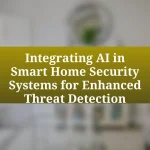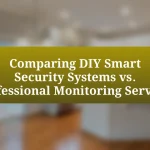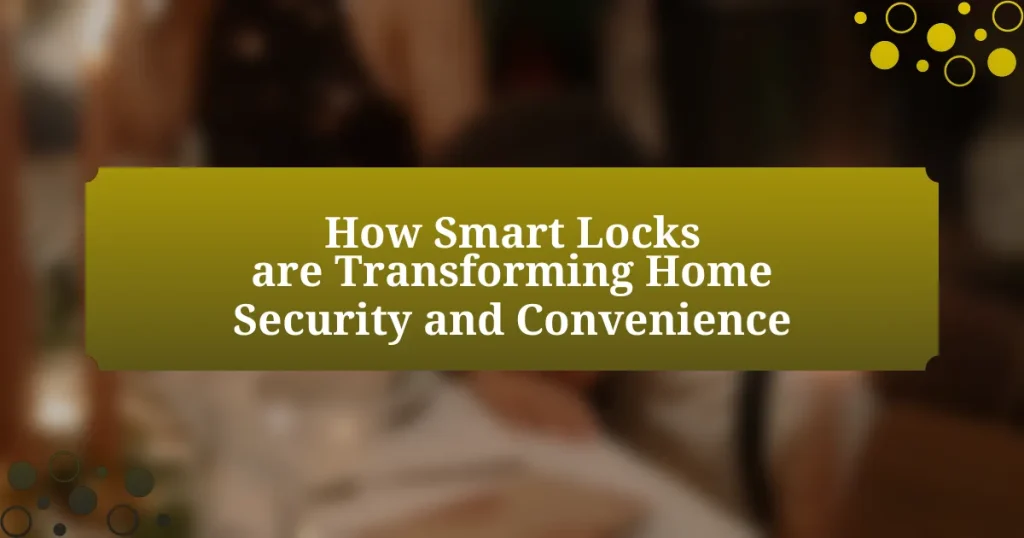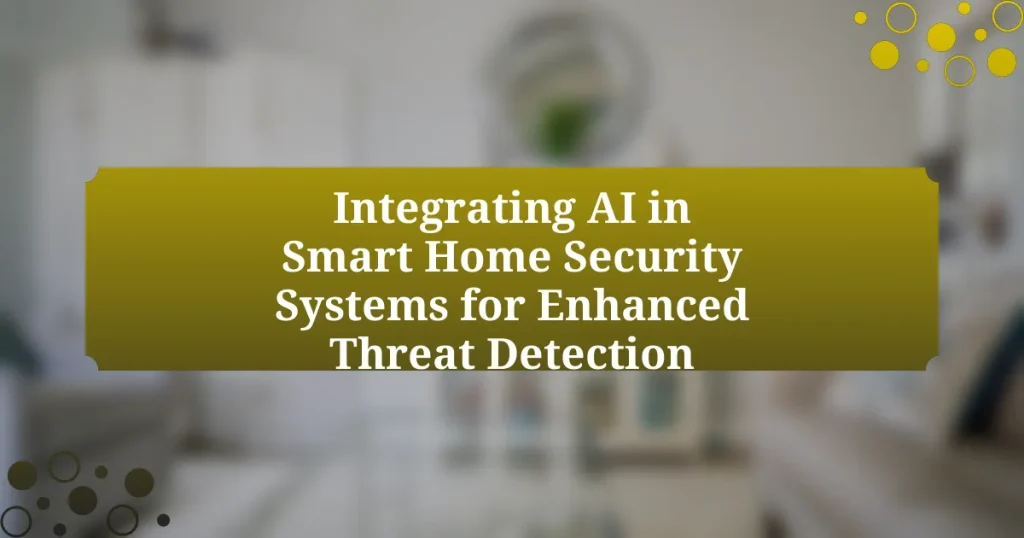An Energy Management System (EMS) for smart homes is a technology platform designed to monitor, control, and optimize energy usage within residential environments. This article outlines the functionality of EMS, including its key components such as energy monitoring, data analysis, and automated control, which collectively enhance energy efficiency and reduce costs. It also discusses the primary benefits of implementing an EMS, factors to consider when selecting a system, and best practices for effective integration into daily routines. Additionally, the article highlights the importance of real-time monitoring, automation, and user-friendly interfaces in maximizing the effectiveness of energy management solutions.
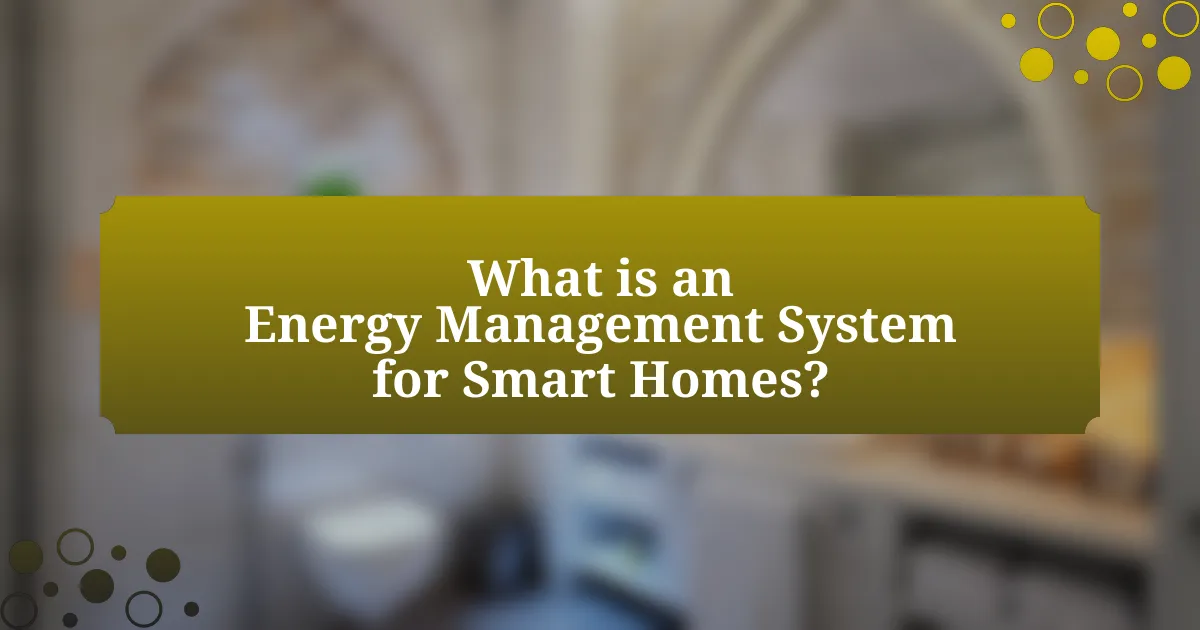
What is an Energy Management System for Smart Homes?
An Energy Management System (EMS) for smart homes is a technology platform that monitors, controls, and optimizes energy usage within a residential environment. This system integrates various smart devices, such as thermostats, lighting, and appliances, allowing homeowners to track energy consumption in real-time and make informed decisions to enhance energy efficiency. Research indicates that implementing an EMS can lead to energy savings of up to 30%, as it enables users to identify patterns in energy use and adjust settings accordingly.
How does an Energy Management System function in a smart home environment?
An Energy Management System (EMS) in a smart home environment functions by monitoring, controlling, and optimizing energy usage across various devices and systems. The EMS collects data from smart appliances, lighting, heating, and cooling systems, allowing homeowners to analyze energy consumption patterns. By utilizing algorithms and real-time data, the EMS can automate energy-saving actions, such as adjusting thermostat settings or scheduling appliance use during off-peak hours, ultimately reducing energy costs and enhancing efficiency. Studies indicate that homes equipped with EMS can achieve energy savings of up to 30%, demonstrating the effectiveness of these systems in managing energy consumption.
What are the key components of an Energy Management System?
The key components of an Energy Management System (EMS) include energy monitoring, data analysis, energy control, and reporting. Energy monitoring involves the continuous tracking of energy consumption through sensors and smart meters, providing real-time data on usage patterns. Data analysis processes this information to identify trends, inefficiencies, and opportunities for energy savings. Energy control refers to the automated management of energy resources, enabling optimization of energy use through smart devices and scheduling. Finally, reporting generates insights and documentation on energy performance, helping stakeholders make informed decisions. These components work together to enhance energy efficiency and reduce costs in smart homes.
How do these components interact to optimize energy usage?
Energy management systems optimize energy usage by integrating various components such as smart meters, sensors, and automated controls. These components work together to monitor real-time energy consumption, adjust settings based on usage patterns, and provide data analytics for informed decision-making. For instance, smart meters track energy usage and communicate with automated controls to adjust heating, cooling, and lighting based on occupancy and time of day, leading to reduced energy waste. Studies show that homes equipped with these systems can achieve energy savings of up to 30%, demonstrating the effectiveness of their interaction in optimizing energy consumption.
What are the primary benefits of using an Energy Management System?
The primary benefits of using an Energy Management System (EMS) include enhanced energy efficiency, cost savings, and improved sustainability. An EMS enables users to monitor and control energy consumption in real-time, leading to optimized usage patterns and reduced waste. According to the U.S. Department of Energy, implementing an EMS can result in energy savings of 10% to 30%, significantly lowering utility bills. Additionally, by facilitating the integration of renewable energy sources, an EMS contributes to a reduction in carbon footprint, aligning with global sustainability goals.
How can an Energy Management System reduce energy costs?
An Energy Management System (EMS) can reduce energy costs by optimizing energy consumption through real-time monitoring and control of energy use. By analyzing data on energy usage patterns, an EMS identifies inefficiencies and suggests adjustments, such as scheduling high-energy tasks during off-peak hours, which can lead to significant savings. For instance, a study by the U.S. Department of Energy found that implementing an EMS can reduce energy costs by 10-30% in commercial buildings. This reduction is achieved through enhanced operational efficiency and informed decision-making regarding energy usage.
What impact does it have on environmental sustainability?
Energy management systems significantly enhance environmental sustainability by optimizing energy consumption and reducing waste. These systems enable smart homes to monitor and control energy use, leading to lower greenhouse gas emissions. For instance, a study by the U.S. Department of Energy found that smart energy management can reduce energy consumption by up to 30%, which directly contributes to decreased reliance on fossil fuels and mitigates climate change impacts. Additionally, integrating renewable energy sources, such as solar panels, with energy management systems further promotes sustainability by utilizing clean energy and decreasing the carbon footprint of households.

What factors should you consider when choosing an Energy Management System?
When choosing an Energy Management System (EMS), consider compatibility with existing infrastructure, scalability, user interface, data analytics capabilities, and cost-effectiveness. Compatibility ensures the EMS integrates seamlessly with current devices and systems, while scalability allows for future expansion as energy needs grow. A user-friendly interface enhances usability for all stakeholders, and robust data analytics capabilities provide actionable insights for energy optimization. Cost-effectiveness is crucial, as it impacts the return on investment and overall budget. These factors collectively influence the effectiveness and efficiency of energy management in a smart home environment.
How do your specific energy needs influence your choice?
Your specific energy needs directly influence your choice of an energy management system by determining the features and capabilities required to optimize energy consumption. For instance, if your household has high energy demands due to multiple appliances or electric vehicles, you may prioritize systems that offer real-time monitoring, automated scheduling, and integration with renewable energy sources. Research indicates that homes with smart energy management systems can reduce energy consumption by up to 30%, highlighting the importance of aligning system capabilities with specific energy requirements.
What types of appliances and devices will you be managing?
You will be managing smart appliances and devices such as smart thermostats, smart lighting systems, smart plugs, smart refrigerators, and smart HVAC systems. These devices are designed to optimize energy consumption and enhance home automation. For instance, smart thermostats can learn user preferences and adjust heating and cooling accordingly, leading to energy savings of up to 10-15% annually, as reported by the U.S. Department of Energy.
How does your home’s size and layout affect system requirements?
A home’s size and layout significantly influence its energy management system requirements. Larger homes typically require more robust systems to manage increased energy consumption and multiple zones, while smaller homes may need simpler systems due to lower energy demands. Additionally, an open floor plan can lead to more efficient heating and cooling, potentially reducing the complexity of the system needed, whereas a multi-level or segmented layout may necessitate more advanced zoning capabilities to ensure consistent temperature control throughout the space. This relationship is supported by studies indicating that energy management systems must be tailored to the specific dimensions and configurations of a home to optimize performance and efficiency.
What features are essential in an Energy Management System?
Essential features in an Energy Management System include real-time energy monitoring, data analytics, automated control, and integration capabilities with renewable energy sources. Real-time energy monitoring allows users to track energy consumption patterns, enabling informed decisions to reduce waste. Data analytics provides insights into usage trends, helping to identify areas for improvement. Automated control features enable the system to optimize energy use based on predefined settings or real-time conditions. Integration capabilities ensure compatibility with various devices and systems, including smart appliances and solar panels, enhancing overall energy efficiency.
How important is real-time monitoring and reporting?
Real-time monitoring and reporting are crucial for effective energy management in smart homes. This capability allows homeowners to track energy consumption instantly, enabling them to make informed decisions that can lead to reduced energy costs and improved efficiency. Studies show that homes utilizing real-time monitoring can achieve energy savings of up to 20% by identifying usage patterns and optimizing energy consumption accordingly.
What role does automation play in energy management?
Automation plays a crucial role in energy management by optimizing energy consumption and enhancing efficiency. Through automated systems, energy usage can be monitored in real-time, allowing for adjustments based on demand and reducing waste. For instance, smart thermostats can learn user preferences and adjust heating and cooling accordingly, leading to energy savings of up to 10-15% as reported by the U.S. Department of Energy. Additionally, automation facilitates the integration of renewable energy sources, enabling homes to utilize solar or wind energy more effectively, thus lowering reliance on traditional energy grids.

How can you evaluate different Energy Management Systems?
To evaluate different Energy Management Systems (EMS), one should assess their features, compatibility, user interface, and cost-effectiveness. Features such as real-time monitoring, data analytics, and automation capabilities are crucial for effective energy management. Compatibility with existing smart home devices ensures seamless integration, while a user-friendly interface enhances usability for homeowners. Cost-effectiveness can be determined by comparing initial investment against potential energy savings and return on investment. Research indicates that systems with robust analytics can lead to energy savings of 10-30%, validating the importance of these evaluation criteria.
What criteria should you use to compare various systems?
To compare various energy management systems for smart homes, consider criteria such as functionality, compatibility, user interface, scalability, and cost. Functionality refers to the features offered, such as real-time monitoring, automation capabilities, and energy usage analytics. Compatibility involves the system’s ability to integrate with existing smart home devices and platforms. User interface assesses how intuitive and user-friendly the system is for homeowners. Scalability evaluates whether the system can grow with the user’s needs, accommodating additional devices or features over time. Cost includes both initial investment and ongoing expenses, ensuring that the system provides value for its price. These criteria are essential for making an informed decision that aligns with specific energy management goals.
How do user reviews and ratings impact your decision?
User reviews and ratings significantly influence decision-making by providing insights into the experiences of others with a product. When selecting an energy management system for a smart home, potential buyers often rely on these evaluations to gauge reliability, functionality, and user satisfaction. Research indicates that 79% of consumers trust online reviews as much as personal recommendations, highlighting their importance in shaping perceptions and choices. Additionally, products with higher ratings tend to have increased sales, as consumers are more likely to choose options that have been positively reviewed.
What is the significance of customer support and service?
Customer support and service are crucial for ensuring customer satisfaction and loyalty in any industry, including energy management systems for smart homes. Effective customer support helps users navigate complex systems, troubleshoot issues, and maximize the benefits of their energy management solutions. According to a study by Zendesk, 87% of customers believe that good customer service can influence their purchasing decisions, highlighting its importance in fostering trust and repeat business. Additionally, responsive customer service can lead to positive word-of-mouth referrals, which are vital for growth in competitive markets.
What are the common pitfalls to avoid when selecting an Energy Management System?
When selecting an Energy Management System, common pitfalls to avoid include inadequate needs assessment, overlooking integration capabilities, and neglecting user-friendliness. Inadequate needs assessment can lead to choosing a system that does not align with specific energy goals, resulting in wasted resources. Overlooking integration capabilities may cause compatibility issues with existing devices, hindering overall efficiency. Neglecting user-friendliness can result in low adoption rates among users, limiting the system’s effectiveness. These pitfalls can significantly impact the performance and utility of the Energy Management System, making it essential to address them during the selection process.
How can you ensure compatibility with existing smart home devices?
To ensure compatibility with existing smart home devices, select an energy management system that supports widely used communication protocols such as Zigbee, Z-Wave, or Wi-Fi. These protocols are commonly adopted by various smart home devices, facilitating seamless integration. For instance, according to a 2021 report by the Consumer Technology Association, over 70% of smart home devices utilize either Zigbee or Z-Wave, indicating their prevalence in the market. Additionally, reviewing the compatibility specifications of both the energy management system and the smart devices before purchase can further confirm interoperability, ensuring a cohesive smart home ecosystem.
What should you watch out for in terms of hidden costs?
When choosing an energy management system for your smart home, you should watch out for installation fees, subscription charges, and equipment costs that may not be immediately apparent. Installation fees can vary significantly based on the complexity of the system and the existing infrastructure, potentially adding hundreds of dollars to the initial investment. Subscription charges for software updates or cloud services can accumulate over time, leading to ongoing expenses that may not have been disclosed upfront. Additionally, equipment costs for compatible devices, such as smart thermostats or sensors, can increase the overall expenditure, especially if they are required for full functionality. Understanding these potential hidden costs is crucial for accurate budgeting and ensuring that the total cost of ownership aligns with your financial expectations.
What are some best practices for implementing your chosen Energy Management System?
To effectively implement your chosen Energy Management System (EMS), start by conducting a thorough energy audit to identify consumption patterns and areas for improvement. This foundational step enables you to tailor the EMS to your specific needs, ensuring optimal performance. Next, ensure that all stakeholders are engaged and trained on the system, as user adoption is critical for success. Additionally, integrate the EMS with existing smart home devices to enhance functionality and data accuracy. Regularly monitor and analyze energy usage data to identify trends and make informed adjustments, which can lead to continuous improvement in energy efficiency. Finally, establish clear goals and benchmarks to measure the effectiveness of the EMS, allowing for ongoing evaluation and optimization.
How can you effectively integrate the system into your daily routine?
To effectively integrate the energy management system into your daily routine, start by setting specific energy-saving goals that align with your lifestyle. For instance, you can program the system to optimize energy usage during peak hours or automate tasks like adjusting thermostats and lighting based on your schedule. Research indicates that households using smart energy management systems can reduce energy consumption by up to 30%, demonstrating the effectiveness of such integration. Regularly reviewing energy reports generated by the system can also help you track progress and make necessary adjustments, ensuring that the system becomes a seamless part of your daily activities.
What troubleshooting tips can help you maximize system performance?
To maximize system performance, regularly update software and firmware to ensure compatibility and security. Keeping your energy management system’s software current can enhance functionality and fix bugs that may slow down performance. Additionally, monitoring system resources such as CPU and memory usage can identify bottlenecks; for instance, if a specific application consumes excessive resources, it may need to be optimized or replaced. Furthermore, clearing cache and temporary files can free up space and improve speed, as accumulated data can hinder system efficiency. Lastly, conducting periodic hardware checks, such as ensuring adequate cooling and checking for dust buildup, can prevent overheating and maintain optimal performance levels.



